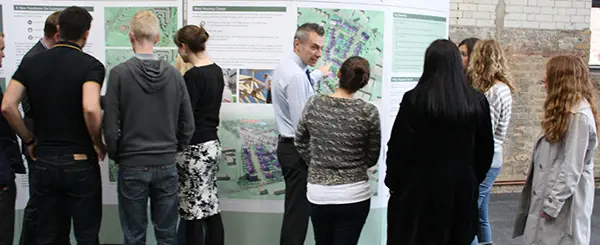
‘Plansplaining’ – The Language of Public Consultation
Grant Swan
20 Jul 2017
In recent years ‘mansplaining’ has become an increasingly common part of the contemporary vocabulary, describing a situation where a man explains something to someone (often a woman) in a condescending or patronising manner, despite the explainee knowing more on the issue than the explainer. To avoid setting myself up for a fall by writing a blog on this issue I am going to focus on a new strain of this phenomenon– ‘plansplaining’.
‘Plansplaining’ is a term I came across through an article on the
City Views website about how planners in the USA have a tendency to talk down to local residents when discussing new development proposals, despite the residents knowing their local area better than the planner does.
This struck a chord after years of attending public consultation events being told “you don’t know what the traffic/ecology/flooding is like here” and, particularly working in the north east without having a Geordie accent, “you’re not from round here so you don’t understand.”
Planners are often guilty of ‘plansplaining’ when discussing development proposals with local communities which can frustrate local residents – with so-called experts telling them that their views on the local area are either incorrect, irrelevant or worst of all ‘not a material planning consideration’.
A residents’ concern over the impact of development in the neighbouring field will not be eased by assuring them that the site is ‘green’ in the most recent SHLAA, the land is an emerging allocation in the draft Local Plan and that the Council cannot demonstrate a robust five year housing land supply.
The most effective means of avoiding ‘plansplaining’ is through the language used when discussing developments with the public. This needs to tread a fine line to ensure that it is not patronising whilst ensuring that the relevant information gets across. By the time a proposal reaches the public consultation stage it is highly likely that a great deal of thought and technical assessment has been undertaken to inform decisions – this needs to be conveyed to residents in the most effective and easily digestible way possible. Planners and the development industry are often guilty of providing too much information through reams of detailed technical information and text at public events.
Our profession has a tendency to talk in acronyms and abbreviations which a non-planner would struggle to decipher – a critical part of effective public consultation is avoiding this industry jargon. Consultation and engagement with local communities plays an ever increasing role in the planning system and the preparation of planning applications, with social media now an accessible tool for the mobilisation of local interest groups.
We need to be better at explaining why there is a demand for development in an area despite existing homes being for sale or shops being vacant. There needs to be a clear understanding of the negative impacts the development is likely to have whilst also being able to explain the benefits of the proposals to the local community.
It’s important to accept that developments will receive objections – the purpose of public consultation and engagement is not to try and persuade all local residents to support the proposals. The real purpose is to ensure that locals understand the full scope of the development and the scale of benefits which can be delivered through the scheme. A successful public consultation strategy will reduce the number of objections to a development and it will ensure that any remaining objections are based on a full understanding of the proposals rather than assumptions and suppositions.



